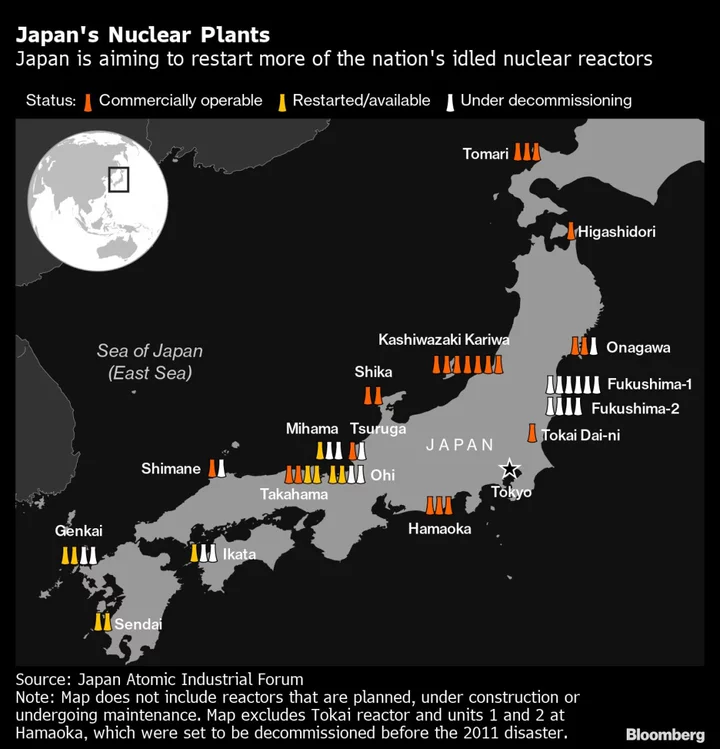Japan is set to win approval to discharge more than a million cubic meters of treated water from the Fukushima nuclear disaster site into the Pacific Ocean, a contentious plan that’s soured ties with neighbors including China.
The International Atomic Energy Agency’s Director General Rafael Grossi will visit Japan from Tuesday to deliver a final report on the safety of the process and meet with officials including Foreign Minister Yoshimasa Hayashi. A domestic nuclear regulator is also set to issue a crucial assessment.
Both studies are poised to give backing to Tokyo Electric Power Co. to begin releasing the water — equivalent in volume to about 500 Olympic-size swimming pools — into the sea, a step that’s needed to allow full decommissioning of the Fukushima site following the 2011 earthquake and tsunami that triggered the world’s worst atomic disaster since Chernobyl.
Japan has assured other nations that the release of the water is safe, is in line with standard industry practice and that it’s necessary, because about 1,000 storage tanks at Fukushima will hit capacity early in 2024. Other countries with nuclear plants already safely discharge similar diluted waste offshore, according to the IAEA.
It also comes as Japan joins a wider global reappraisal of nuclear power, with several nations seeking to boost energy self-sufficiency by reviving idled reactors, adding plants or investing in new technology. Prime Minister Fumio Kishida is aiming to build on improving domestic support for the energy source, and Japan’s efforts to complete the closure of the Fukushima site are seen as a crucial in inspiring confidence.
Read more: Nuclear Power’s Revival Reaches Home of Last Meltdown
Despite Japan’s diplomatic push, the discharge plan is complicating some global relationships.
The ocean is “not Japan’s private sewer,” Chinese Foreign Ministry spokesman Wang Wenbin said last month, warning the proposed release carries risks for the country’s neighbors and Pacific Island nations. Wang called it a selfish move “that puts the common interests of all humanity in jeopardy.”
Japanese cosmetics brands have been targeted by a viral campaign tied to the issue that spread unproven safety allegations on Chinese social media platforms. In South Korea, demand for sea salt has rocketed as consumers stockpile the condiment amid worries the release of wastewater could taint future supplies.
While the central government in Seoul hasn’t pushed back against Japan’s plans publicly, a survey by the Yomiuri newspaper and South Korea’s Hankook Ilbo conducted in May found 84% of respondents opposed the discharge. A separate poll found almost three-quarters of South Koreans surveyed didn’t trust a delegation of experts sent from Seoul to review Japan’s preparations.
The Pacific Islands Forum, a group of 18 nations including Fiji, Papua New Guinea and Australia, has urged Japan to consider alternatives and called for additional discussions on the risks.
“People’s fears and uncertainties in the region are real, however safely the release will be handled, and however minimal the risk is,” said Nancy Snow, a reputation security consultant in Tokyo and author of a book on Japan’s public diplomacy. “Their concerns cannot be taken lightly or dismissed.”
Japan announced in 2021 it planned a gradual release of about 1.3 million cubic meters of treated wastewater from the Fukushima Dai-ichi nuclear power plant that has accumulated at the site since 2011. Tepco cycles in water to keep debris and fuel at the wrecked nuclear reactors cool, and the contaminated liquid — along with other groundwater and rain — is processed to remove most radioactive elements. The treated water, which still contains tritium, has been collected and stored.
Tepco expects the fleet of about 1,000 storage tanks to reach maximum capacity between February and June next year and the utility has argued it cannot continue to clear space for additional vessels because that’s needed for other parts of the decommissioning process. Storing the water also carries risks of leaks, which are amplified by the nation’s status as one of the most earthquake-prone countries.
In one of its preliminary reports in April, the IAEA said Tepco had taken into account issues raised in previous safety reviews and had “made significant progress to update its plans,” signaling the agency is likely to grant final approval. Grossi will visit Fukushima during his trip to Japan and open an IAEA office at the site, the agency said Friday.
Tepco plans to mix the treated fluid with seawater to dilute the concentration of tritium to “well below” both Japanese government and World Health Organization guidelines, before discharging it into the ocean over the course of as long as 40 years through an undersea tunnel. Tritium has a radioactive half-life of a little over 12 years, according to the IAEA.
Japan’s government has not yet set any specific date to begin releasing the water, and has said it will continue to hold talks with local communities, including the fishing sector, to try to alleviate their concerns.
Releasing water from nuclear power plants is a standard practice and most operations globally release small amounts of tritium and other radioactive material into rivers and oceans, the IAEA said previously.
--With assistance from Ben Westcott.

